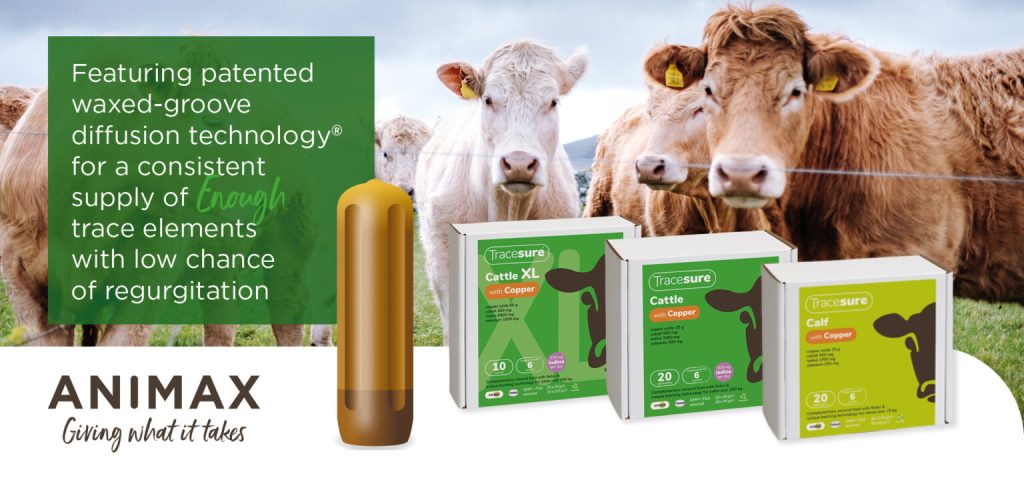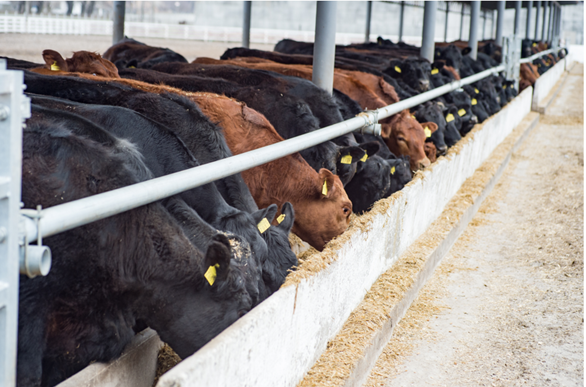It is really important that housed-beef systems proactively plan for the winter housing period to ensure we see the benefits at the other end. Here’s some non-negotiables for maximising beef cattle health and performance.
1. Focus on immunity
Beef youngstock can be affected by a multitude of diseases namely pneumonia, IBR, BVD, Leptospirosis, and RSV during the winter housing period.
Sampling can be undertaken by your vet to determine the pathogens on your farm alongside other variable factors before determining a suitable pneumonia vaccination strategy. Blood samples or nasal swabs can be taken and can often be funded under animal health pathways through Farming Connect (Wales) and Animal Health and Welfare Review (England).
An unavoidable level of stress at housing from diet changes, weaning and the change of environment will impact on the animals ability to build up immunity. When vaccinating for respiratory disease prior to housing, ensure it is administered at the optimum time – usually 3 weeks before the winter housing period – to ensure the animal builds up adequate immunity first.
Top Tip: Clipping the hair from the back of the cattle at housing can help to prevent overheating and reduce sweating, which then reduces the humidity of the shed which in turn can aid reduction in pneumonia outbreaks.
2. Control the parasites
Parasite control during winter housing is good practice to ensure cattle are free from any production-limiting parasite burdens.
Winter parasite control depends on each individual system, specifically timings of housing and age of cattle, but should always follow Faecal Egg Count (FEC) testing and fluke sampling to ensure treatment is given responsibly where needed, thus reducing the risk of resistance. Advice should be sought from suitable professionals SQP’s and vets who will study the farm’s history and current status to plan accordingly.
Recommended Reading
It’s important to stress that herd health plans and the control of common cattle diseases is farm-specific, and farms must work closely with their vet to form sustainable and responsible strategies.
Top Tip: APHA are running a project ‘What Worms? Project’ where samples can be submitted through your vet (England & Wales) from 10 calves which have been grazed for their first season. An opportunity to receive a free FEC and to help towards a study looking at benzimidazole (BZ) resistance.
3. Optimise the environment
Feeding Space
Sufficient feeding space is one of the most basic requirements for enabling feed intakes when in winter housing.
It’s important to keep the feed space and feed offered clean and well in reach for the cattle, a smooth floor material will make this easier for consumption. An easily accessible feed space will reduce the labour needed to push feed and remove waste feed. With whichever feed option used – be that barriers, troughs, rails – it is important to maintain these prior to the housing period to ensure there are no protruding sharp edges which could cause injury. Inspection of the facility should be continued whilst cattle are housed.
Feed rails should be around 500mm high for adult cattle with a smooth edge and neck rails should be ideally adjustable from 1150-1250mm for adults and 900-1100mm height for younger cattle from floor level.
Group size, cattle size and feed type will influence the feed space and barrier width required by cattle. The AHDB Better Cattle Housing Design resource goes into further depth in housing but as a gauge for cattle weighing between 300-600kg the requirements for feed barrier width are between 500-650mm per head.
| Animal Weight (Kg) | Width of feed barrier (mm/animal) | Ad-Lib Feeding (mm) |
| 200 | 400 | 150 |
| 300 | 500 | 150 |
| 400 | 550 | 190 |
| 500 | 600 | 240 |
| 600 | 650 | 280 |
| 700 | 700 | 320 |
| 800 | 750 | 320 |
Source: Adapted from the Red Tractor Beef & Lamb Assurance Standards
Water Supply
Intake of fresh clean water is positively correlated with feed intake and essential for productivity. Growing and finishing cattle can consume between 15 and 75 litres of water each day so a good supply is needed to meet demand at peak times.
Water troughs should be kept clean and free from feed, bedding, and manure. Regular inspection and cleaning can help with this and locating troughs away from direct feed sources will minimise the risk of feed contamination. Tipping troughs can speed up the cleaning process however it is important that there is sufficient drainage in the vicinity to reduce the build-up of moisture within the cattle housing.
Bedding Area
Livestock will produce moisture through their breath, urine, faeces and sweat. Poor drainage and damp bedding can also contribute to humidity build up. Selecting the right bedding and implementing a proactive cleaning rota will help reduce the moisture build up which could negatively impact the health and performance of the housed cattle.
It can be useful to insert a step/ridge of a maximum 300mm between the feeding and bedding area when loose housed to segregate straw bedding. This can help to avoid slurry contamination as feeding and loafing areas will be cleaned more regularly than the bedded area. Passages for cattle less than one year of age will require a passage width of at least 2 meters to allow for enough space to feed and move around.
Appropriate machinery such as a straw chopper can speed up bedding time, whilst reducing stress on the livestock and labour required for the task.
Ventilation
Fresh air is a primary requirement for optimising health and productivity. Sufficient ventilation will facilitate the removal of heat, moisture, dust, gases, and micro-organisms from the building. Fresh air plays a vital role in eliminating pathogens, bacteria, and viruses.
According to the AHDB Better Cattle Housing Design resource; 100% clean, fresh air can kill airborne bacteria and viruses 10–20 times quicker than 50% clean, fresh air. It is important that buildings are suitably ventilated to remove contaminated air and replenish with fresh air without creating a draught and exposing stock to excessive wind speed.
4. Sample your forage
We need to start out by looking at our forage analysis results before making any feeding and management decisions. The feed value analysis will detail energy and protein values along with fermentation values. This will determine the amount of forage the cattle will need to perform at the rates set out. The mineral analysis will define the macro minerals and trace elements within the forage.
Sampling can be performed by an array of professionals – nutritionists, merchants, contractors etc. Samples should be taken using a corer in a ‘W’ shape at several locations across the clamp, not just at the clamp face.
Analysing multiple samples over the winter will detect changes in the silage as you move through the clamp or when moving to another clamp. The frequency of sampling will depend on whether the clamp was filled in blocks, layers, multi cuts etc.
If feeding big bales, samples should be taken from each cut or fields as identifiable.
Winter forages may well supply enough energy and protein needs for your livestock; however, most are deficient in one or more trace elements. An absence of any of the essential trace elements in winter forages – cobalt, copper, iodine, and selenium – will impact on metabolic processes. This will have a knock on effect on digestion, immunity, reproduction, and growth.
This can manifest into costly treatments and costly underperformance. We’ve worked hard and invested a lot of time and energy into making the forage, so it’s vital we don’t fall at the last hurdle and balance the forage as needed to get as much out of it as we can.
Top tip: The transition from grazing-based diets to silage-based diets should not happen overnight but should gradually transition to give the rumen time to adjust. Without this, cattle are at a greater a risk of having acidosis, stomach ulcers and liver abscesses. Weaning calves should be creep-fed for 3-6 weeks before housing to help develop their rumen and avoid any dips in intakes at a time when they need it most.
5. Supplement with precision
Almost all soil, and therefore grass and forage, is deficient in one or more of the trace elements essential to an animals digestive, immune, and reproductive system.
Cattle that have enough trace elements coming indoors will have a better supported immune function and response from any vaccines as well as a greater ability to digest and convert what they eat into liveweight gains heading indoors.
Cobalt
Important in growing ruminants, Cobalt is converted by rumen bacteria into Vitamin B12 critical for energy cycles, metabolism, cattle growth, and pregnancy.
Cobalt is only stored in the animal in small quantities. A continuous supply is needed. Tracesure offers a form of cobalt that is available in the rumen where the bacteria can utilise it.
Selenium
Selenium is critical for normal cell function and essential for effective immune responses to viral, bacterial and parasite encounters. Selenium also supports the recovery from routine cell damage, commonly referred to as oxidative stress.
ANIMAX Tracesure® with its specialist diffusion technology, contains the highest levels of selenium of any bolus in a safe form.
Iodine
Iodine is an essential component of the thyroid hormone responsible for regulating metabolism.
ANIMAX Tracesure® contains two types of iodine to ensure an immediate supply as well as a longer term supply.
Copper
Copper is required by cattle for enzyme function and can promote positive weight gain.
ANIMAX Tracesure

By proactively bolusing with ANIMAX Tracesure®, featuring patented diffusion technology that offers a controlled and consistent supply of the right trace elements in the right amounts, you can be sure that every animal is getting enough through the winter housing period – no more or less, and no peaks or troughs.
The ANIMAX Tracesure® cattle range offers copper in the form of copper needles that lodge in the rumen wall before gradually dislodging and passing through into the abomasum where they are absorbed in the small intestine and stored in the liver. This facilitates a more consistent and continuous long-lasting supply of copper compared to other sources.
| Trace Element | ANIMAX Tracesure® Calf (75kg+) | ANIMAX Tracesure® Cattle (200-500kg) | ANIMAX Tracesure® Cattle XL (500kg+) |
| Cobalt | ≈ 2.8 mg | ≈ 2.8 mg | ≈ 2.8 mg |
| Copper | ≈ 72.5 mg | ≈ 145 mg | ≈ 290 mg |
| Iodine | ≈ 9.4 mg | ≈ 18.9 mg | ≈ 37.8 mg |
| Selenium | ≈ 1.4 mg | ≈ 2.8 mg | ≈ 5.6 mg |
Top tips for bolus application ready for winter housing
SAFE! Ensure you have a suitable handling system; a good crush and head scoop will help.
RESPECT! Bolusing is invasive so care is needed for ease and safety of application.
TIME! Once the applicator has been removed, ensure the bolus has been ingested.
Veterinary and nutritional advice should be sought before supplementation, particularly with regards to copper and selenium supplementation for the reasons already outlined.
For more information contact you local specialist


